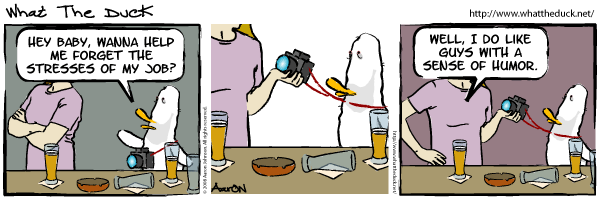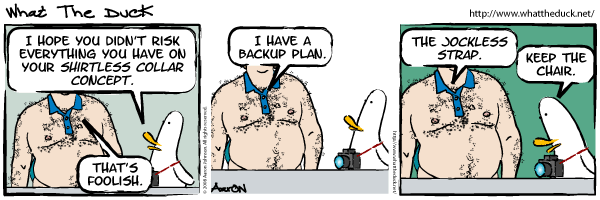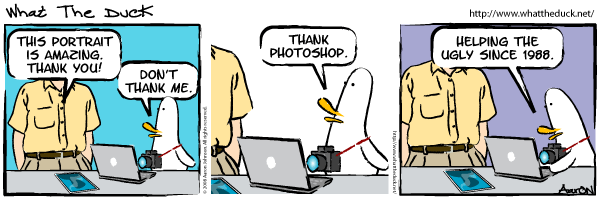— Детка, не хочешь помочь мне снять напряжение после работы?
— Что ж, мне очень нравятся парни с чувством юмора.
Месяц: Февраль 2008
Фотоссылки
- Quick Look at Balancing Flash at Sunset. Как снимать портреты на фоне заката, используя вспышку. Задача сбалансировать свет в данном случае достаточно тривиальна, но тем не менее. Вообще, когда я снимал подобное, то делал так: матричный замер по фону; камеру в режим M и так подобрать экспопару, чтоб фон недосвечивался на одну ступень — так небо драматичнее получается; переключаем камеру в точечный или центровзвешенный замер; вспышка в режиме TTL (коррекция по вкусу, но обычно не нужно). Этот алгоритм, кстати, почти всегда хорошо работает, когда надо снять относительно темный объект на фоне чего-то светлого и яркого.
I started taking shots at AV and chimped one in. Looked close so I set my manual to that exposure and shot one. No flash. This let me get an overall view of the scene as it was in front of me. Most of the time, the camera will make a lighter image than I like because it is trying to ‘average’ the scene. (NOTE: If I had wanted to meter this image, I would have had to run down the beach and then carefully walk toward Briana so my footprints would be less noticeable. Take the meter reading and then go back on my steps and around to get the shot. Time’s a wastin’ and I chose to chimp.)
- So How Many Pixels Does It Take To Make A Face. Прикольно чувак считает количество пикселей на лице жениха «от уха до уха».
Well, I printed a copy of the wedding photo shown at the 4 different resolutions from 4368px down to 1000px across and assessed the final printed image. Somewhat to my surprise, the images down to 2000px across looked fine – even under close inspection. Even the 1000px image looked OK at the normal viewing distance of 12 – 20 inches. Closer inspection showed it was quite blurry though. That explains the comments from the lab tech 6 years ago – I had quite small head sizes in the image in question. I learned from that experience to pose my groups a bit tighter – so I could get closer and get bigger heads in the image and to alleviate the “low pixel count” head problem.
- Sometimes You Just Have to Punt. Еще один феерический «сетап» от известного стробиста David Tejada.
I was recently in Key Largo to photography the construction of a large bridge over Jewfish Creek. The current bridge was build in 1944, is 223′ long and is of the old drawbridge style. When a boat to tall to pass under the bridge, traffic would be stopped and the drawbridge would opened to allow the boat to pass through. With as much traffic that travels on this highway (Highway 1 to the Keys)they needed a new bridge.
- How to get a more natural photograph of a group. Забавный способ, надо будет попробовать.
Tell the group you’ll be taking a few images to ensure you get a good picture.
Count to three, take a shot, pause for 1 second, take a second shot.
The second shot will find most of the people in the group will have relaxed smiles as opposed to forced smiles. It won’t work every-time, but I’ve had much success with it in the past. - Панорамостроение. Очень подробная статья о том, как снимать панорамы и как их потом склеивать на примере программы Autopano Pro.
Изготовление панорамы – отличный технический приём, позволяющий перешагнуть через некоторые ограничения возможностей фотоаппаратуры. Раньше «сшивание» цифровых фотографий (про «плёночную» эпоху я уж и не говорю) было делом муторным и трудоёмким, так как использование ранних версий программного обеспечения для автоматизированного создания панорам давало весьма убогие результаты, и приходилось делать всё вручную. Да, трудные были времена… Теперь же имеются программные инструменты, поистине волшебные по своим возможностям, и создание фотопанорам превратилось из кропотливого труда в увлекательное занятие.
Утки #416
Выпуск #346
 www.thedieline.com. Отличный блог, посвященный дизайну упаковок. С его страниц вы узнаете о последних веяниях в упаковочной индустрии, увидите лучшие образцы жанра и, конечно же, полюбуетесь на худшие. Редкий сайт подобного толка не содержит раздела «порка».
www.thedieline.com. Отличный блог, посвященный дизайну упаковок. С его страниц вы узнаете о последних веяниях в упаковочной индустрии, увидите лучшие образцы жанра и, конечно же, полюбуетесь на худшие. Редкий сайт подобного толка не содержит раздела «порка».
TheDieline.com was founded by Andrew Gibbs, a senior packaging designer in Southern California. “I started The Dieline because as a packaging designer, I wanted a resource where I could go to see the latest design trends and styles. When he realized something like that didn’t exist, The Dieline was born.” The Dieline was launched in January of 2007, and has quickly become the web’s leading packaging design blog. “Product packaging not only secures and protects a product, it is the direct link between the brand and the consumer. It is what determines if a product will be a success or failure. Packaging plays a pivotal role in influencing a consumer’s perception of the brand and product.” TheDieline.com defines good packaging and is the ultimate resource for packaging designers in the field.
 Set a hacker alarm on your Web mail box. Изящный, хотя и не 100%-надежный способ узнать, не добрались ли чьи-то шаловливые ручки до вашего емейл-аккаунта. А уж после того, как эта статья попала на главную страницу Digg.com, так совет и вовсе потерял актуальность — чисто академический интерес.
Set a hacker alarm on your Web mail box. Изящный, хотя и не 100%-надежный способ узнать, не добрались ли чьи-то шаловливые ручки до вашего емейл-аккаунта. А уж после того, как эта статья попала на главную страницу Digg.com, так совет и вовсе потерял актуальность — чисто академический интерес.
Your Web mail account is a treasure trove of private and potentially valuable information — and thieves know it. In an online interview, one phisher claimed to make thousands of dollars every day by breaking into people’s E-mail accounts and searching for messages that contain financial details.
 Women Photographers. Подборка фотографий, сделанных известными «фемино-фотографами». Здорово все-таки, что известная шутка про женщин программистов (и геологов, кстати) и морских свинок, не действует в этой области.
Women Photographers. Подборка фотографий, сделанных известными «фемино-фотографами». Здорово все-таки, что известная шутка про женщин программистов (и геологов, кстати) и морских свинок, не действует в этой области.
I often wish I had more female mentorship and inspiration, but I guess it is out there if you are willing to look. So hopefully someone will find something or someone inspiring in the list. I am sure I have missed some artists, so feel free to email me your additions.
 Tips and tricks for climbing photography. Практически всеобъемлющая статья о фотосъемке на скалах: как, где, чем и почему.
Tips and tricks for climbing photography. Практически всеобъемлющая статья о фотосъемке на скалах: как, где, чем и почему.
There are different ways to do climbing photography, depending on where you are climbing and what you want to show. For instance, take mountain climbing: basically you take pictures while you are climbing. If you take only a close up of your partner, it’s not too interesting in itself so you need to include some background to show how high up you are, what kind of climbing your are doing… So it’s actually closer to scenic photography, except that you want to convey that you are in the picture (or the back of it), living an adventure and not just taking a picture of some mountain from the road. It’s enough to get the camera out every once in a while and take a shot and anyway you can’t move away to show the general view. Back home you can sort out the 3 basic kinds of pictures that come out of such a trip: climber close up, pure landscape and climber(s) included in scenery. It’s quite important to vary those 3 types of shots if you are doing the slide show of an expedition for instance: no one wants to see 100 pictures of mountains in succession, even if they are all perfect.
 16 Lies and half-truths in the Camera business. Очень интересная статья о том, что недоговаривают и в чем откровенно врут потребителям производители цифровых фотокамер.
16 Lies and half-truths in the Camera business. Очень интересная статья о том, что недоговаривают и в чем откровенно врут потребителям производители цифровых фотокамер.
There are a lot of half-truths going around about photography. Generally, the various photographic equipment companies spread one or two of them, and then the various photography magazines and megasites play along because they realize that to go against what the photography companies want is a great way to not get access to the latest and greatest for review.
 Они не хотят креативный дизайн. Статья на тему: если вы все такие умные, то почему строем не ходите. Ну или почему у семи нянек дите без глазу: все такие дизайнеры передовые, а получается унылое… ну вы поняли.
Они не хотят креативный дизайн. Статья на тему: если вы все такие умные, то почему строем не ходите. Ну или почему у семи нянек дите без глазу: все такие дизайнеры передовые, а получается унылое… ну вы поняли.
У практикующих дизайнеров и у заказчиков как правило совершенно разное понимание загадочного слова “Креатив”. Заказчики – они все чуть ли не до единого в первом интервью говорят о том, что дизайн должен быть суперклассный, креативный, вы же таланты! Дизайнеры, со своей стороны, тоже чаще всего не переносят рисовать “почти” одно и то же, и мечтают о заказе, где можно развернуться во весь размах их безудержной фантазии.
 Yellowtail – Flong. Небольшая коллекция забавных программно-графических эффектов, созданных на Java. Поправьте меня, если я неправ, но не кажется ли вам, что эта несомненно мощная платформа в последнее время используется немного неправильно.
Yellowtail – Flong. Небольшая коллекция забавных программно-графических эффектов, созданных на Java. Поправьте меня, если я неправ, но не кажется ли вам, что эта несомненно мощная платформа в последнее время используется немного неправильно.
Yellowtail (1998-2000: Golan Levin) is an interactive software system for the gestural creation and performance of real-time abstract animation. Yellowtail repeats a user’s strokes end-over-end, enabling simultaneous specification of a line’s shape and quality of movement. Each line repeats according to its own period, producing an ever-changing and responsive display of lively, worm-like textures.
Фотоссылки
Я опять без картинок, хорошо?
- What makes a great portrait? Отличная статья о том, что делает простое фотоизображение человека хорошим портретом.
What makes a great portrait? What are the elements that make a portrait really special?
- Top 10 Movies About Photographers. Десять фильмов о фотографах. Из всего списка я смотрел только “Full Metal Jacket”. Отличный фильм, кстати.
Why write a “Top 10 Movies About Photographers!” list on Your Photo Tips? Because we can learn some lessons from movies, even if they’re fictional and not really accurate as far as technique or equipment goes. The biggest thing I get from them is inspiration. Do you ever get that feeling after a movie, you know, the feeling that screams “I should be lucky enough to have that kind of drive!” or whatever? After watching Rocky I can totally take on the world (or at least it inspires me to hit the gym). Anyway, maybe this list will help you get off the couch and go create some great photography. As T.O. would say “Get your popcorn ready!”
- Build A Tilt-Shift Lens for Your SLR for Cheap. TS-объектив практически нахаляву.
I haven’t posted a good camera modification in a while, so it feels good to present you with this new tutorial on how to build your own tilt-shift lens. Have you seen those photos where only a small part of the picture is in focus and the rest of the image gets dramatically blurred? If you ever wondered how this effect is created, chances are the picture was taken with a tilt-shift lens. Most lenses are fixed exactly parallel to your lens because that is the position that will distribute the light evenly and keep focus at a fixed distance. A tilt-shift lens is different because it allows you pivot the lens. By “tilting” and “shifting” the lens you can throw things out of focus in unconventional ways. Using a tilt-shift lens is a fun way to inject your photos with drama and controlled distortion. Here is a link to a good Flickr gallery full of examples of tilt-shift to give you an idea of what is possible with a tilt-shift lens.
- Homemade Bellows Lens for Nikon. Еще один вариант самодельного TS-объектива.
Luckily enough when I was in Keeble and Schucat today I saw an old folding camera on sale for only $5.00! bargain. Remembering John’s notes on the bottom of his page, he thought that they could be a good lens to attempt instead of using a plastic film bag since the bellows are built in. Plus much cheaper than using an enlarger lens.
- A wealth of Lightroom tutorials. Секреты работы с Adobe Lightroom из первых рук.
Digital photography experts Rob Sheppard and Tim Grey have created a wide range of Lightroom tutorials for the Adobe Design Center.
- Photographers Who Still Use Film. Подумать страшно: полароид закрывает производство «моментальной» фотографии, а кто-то еще продолжает снимать на пленку.
With even Polaroid dropping production of its instant film, it really does look like the end of the road for analog photography.
- Location Lighting… in the Philippines! Joe McNally’ делится секретами мастерства в плане работы со светом.
I just finished a teaching stint at PhotoWorld Manila, in the Philippines, and I can say I have never been more warmly welcomed or graciously treated by any host, at any time. The Filipino people are amazingly easygoing and friendly, and, rabidly interested in all things about digital photography. The conference was a non-stop love fest, and a non-stop laugh fest among the speakers; Eddie Tapp, Judy Host, Amy Cantrell, Ken Sklute and Hadi Doucette.
- “Правило третей”? Нет – “правило трех”! Забавно, то-ли примеры так удачно подобраны, то-ли это действительно работает.
Правило третей? Нет – правило трех!
Одно из первых правил, которое узнает начинающий фотограф – это правило «золотого сечения» или правило третей. Напоминает игру «крестики-нолики». Делим кадр такой вот своеобразной решеткой и помещаем в ее узлы наиболее значимые элементы композиции. Все достаточно просто. Есть, конечно, более точные и подробные определения и уточнения, но мы их не будем рассматривать. Поговорим же о другом, достаточно простом приеме, который можно назвать как «правило трех». - Cheap Photography Light Box Setup. Самодельный лайтбокс из подручных материалов.
Inspired by the excellent posts on the home light table setup over at diyphotography.net I took a quick trip the local cardboard box factory this weekend to begin the setup of my own home made light box table. And by local cardboard box factory I mean dumpster diving behind some of the big chain stores that sell refrigerators. Of course you could always walk in and ask a sales associate for a box, but sometimes dumpster diving is more fun – you never know what you might find.
- Street tips. Советы для начинающих стрит-фотографов.
I know this topic has been covered extensively before, so my aim here is not to give a definitive guide to street photography but rather to share my recent experiences. I strongly believe that failure is the key to success, and it is with my recent failures in mind that I undertake this post.
- Koh Global Home. По-моему, массовая паранойя по-поводу пыли на матрицах ЦФК достигла каких-то неприличных масштабом.
Sensor Dust is a chronic problem effecting Digital SLRs. And when it comes to dust, what you don’t see can really impact your picture. The Patent Pending Koh Dustless Bag System, designed by a bio-medical engineer, creates a dust-free environment to safely exchange your camera lenses without risking dust on your sensor. The HEPA air filtering device inside the Koh Bag removes dust and other particulates to create a safe dust-free enclosure to change out lenses. The Koh Dustless bag is ruggedly constructed of transparent polyvinyl with durable stitching. The Bag is easily collapsible so you can take it anywhere you go and safely change out your camera lens without fear of sensor dust.
- Contessa Nettel Cocarette on the Sony DSLR A100. А-а-а-а!
A Contessa Nettel Cocarette camera attached to my Sony DSLR A100 by means of sticking an 11mm M42 extension tube to the rear port of the camera. The moving lens assembly allows infinity focus to be achieved, enabling the 105mm f/4.5 Carl Zeiss Tessar lens to be utilized with the DSLR. (Or indeed, almost any SLR capable of accepting M42 lenses either directly or with an adapter…)
- Фотобокс для бережливых. Еще один вариант лайткуба для нищебродов.
Пришла в голову идея построить сооружение из тонких пенопластовых плит, которые используются для отделки потолков. Берём 5 панелей, при помощи скотча соединяем и в итоге получаем забавный пенопластовый домик )) Внутри закрепляем белый лист бумаги, сверху ставим вспышку и бокс готов!
Утки #414
Что в кофре у «папарацци»
Очень любопытное видео.
RAW Play: еще несколько интересных вариантов
Вот, прислали еще несколько картинок. Как видите, можно и позже присылать — все опубликую, мне не жалко. Картинки кликабельны, по ссылкам — описание процесса обработки.
Под катом несколько картинок и трафик.
Утки #413
Кэтрин Айсманн
Может я чего-то не понимаю, но по-моему всемирно известная «Photoshop-гуру» Кэтрин Айсманн (Katrin Eismann) достаточно посредственный фотограф.
Поправьте меня, чтоль.



